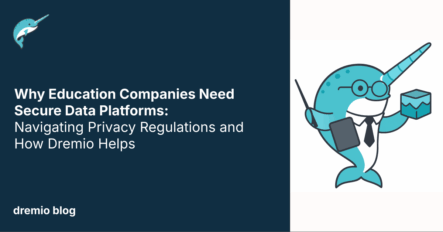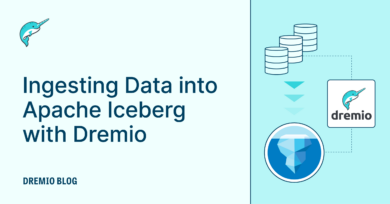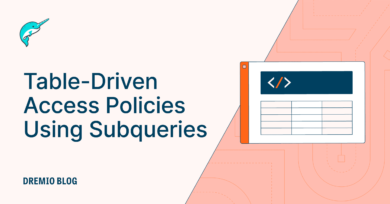11 minute read · September 18, 2025
Why Education Companies Need Secure Data Platforms: Navigating Privacy Regulations and How Dremio Helps
· Head of DevRel, Dremio

Data has become the backbone of decision-making for the education industry. From student performance metrics to administrative records and learning management systems, institutions are generating and managing more information than ever before. But with this growth comes heightened responsibility. Strict regulations like FERPA in the U.S., GDPR in Europe, COPPA for children’s online privacy, and a growing wave of state-level privacy laws demand that educational organizations safeguard sensitive student information with the same rigor as financial or healthcare data.
At the same time, the education sector has become a prime target for cyberattacks, with breaches exposing personal details that can impact students for a lifetime. Schools, universities, and edtech companies face the dual challenge of enabling secure, governed access to data while remaining agile enough to support analytics, AI, and personalized learning initiatives.
This is where Dremio stands out. As a unified, secure data lakehouse platform, Dremio helps education companies simplify compliance, strengthen security, and unlock the full value of their data, without sacrificing speed or accessibility.
The Complex Regulatory Landscape of Education Data
Educational institutions operate under a patchwork of data privacy and security regulations that are both broad and sector-specific. In the United States, the Family Educational Rights and Privacy Act (FERPA) is the cornerstone, granting parents and eligible students control over access to education records. Complementing it, the Protection of Pupil Rights Amendment (PPRA) restricts the collection of sensitive information without consent, while the Children’s Online Privacy Protection Act (COPPA) governs how online services handle the data of children under 13. The Children’s Internet Protection Act (CIPA) further requires schools using federal funding to implement internet safety and content-filtering policies.
Outside the U.S., regulations such as the General Data Protection Regulation (GDPR) in Europe impose strict consent, access, and data minimization requirements. Meanwhile, a surge of state-level laws, including California’s Student Online Personal Information Protection Act (SOPIPA) and new privacy frameworks rolling out in states like Minnesota and New Jersey, add another layer of compliance complexity for K-12 districts and higher education institutions.
Together, these overlapping laws demand rigorous data governance, robust security controls, and complete transparency into how student information is collected, stored, and shared. For many education companies, keeping pace with this shifting landscape is as challenging as it is essential.
Compliance Challenges Facing Education Companies
While regulations provide a framework for protecting student data, actually achieving compliance is no small feat. Most education organizations face a mix of legacy systems, siloed applications, and growing demands for data-driven insights. Student Information Systems (SIS), Learning Management Systems (LMS), financial aid platforms, and third-party edtech tools all generate critical but fragmented data. Integrating these sources securely, without creating new risks, is a constant struggle.
Compounding the challenge is the rising tide of cyber threats. According to recent studies, the education sector consistently ranks among the top industries targeted by ransomware and phishing attacks. Universities and K-12 districts often have limited IT resources, leaving them vulnerable to breaches that can expose highly sensitive records, from Social Security numbers to health information.
On top of security risks, institutions must navigate the tension between access and control. Educators and administrators need timely insights to improve outcomes, personalize learning, and optimize operations. Yet, without strong governance, granting broader access can inadvertently create compliance gaps or expose data to misuse.
The result is a delicate balancing act: how can education companies enable secure, governed access to data while ensuring compliance with a complex and evolving regulatory landscape?
Try Dremio’s Interactive Demo
Explore this interactive demo and see how Dremio's Intelligent Lakehouse enables Agentic AI
What a Secure Data Platform Must Deliver
To meet the demands of modern education while staying compliant, institutions need more than just a database or reporting tool, they need a comprehensive data platform built with privacy, governance, and scalability at its core. A truly secure platform for education should provide:
- End-to-End Data Protection: Encryption of data both at rest and in transit to ensure sensitive student records are never exposed.
- Granular Access Controls: Role-based and fine-grained access control (RBAC/FGAC) so that administrators, teachers, and third-party partners only see the data they are authorized to view.
- Comprehensive Auditing and Monitoring: Full visibility into who accessed what data, when, and how, enabling transparency for regulators and internal stakeholders alike.
- Unified Data Access: The ability to connect disparate systems, SIS, LMS, ERP, CRM, and edtech platforms, into a single governed environment for analytics without compromising compliance.
- Regulatory Alignment: Built-in governance features that map to regulatory frameworks like FERPA, COPPA, GDPR, and state-specific privacy laws, reducing the compliance burden on IT teams.
- Scalability and Flexibility: Support for growing data volumes and evolving educational technologies, ensuring the platform can adapt as institutions adopt AI, advanced analytics, and personalization.
These are no longer “nice-to-haves” but table stakes for education companies navigating today’s regulatory and cybersecurity landscape. Without them, institutions risk noncompliance, reputational damage, and the erosion of trust with students and parents.
How Dremio Meets These Needs
Dremio was designed with secure, governed, and scalable data access at its core, making it an ideal platform for education companies navigating today’s regulatory pressures. Here’s how it addresses the key requirements:
- End-to-End Security: Dremio supports encryption for data at rest and in transit, ensuring student records remain protected across all environments.
- Granular Access Controls: With robust RBAC and fine-grained access control (FGAC), institutions can enforce who sees what, down to the column or row level, aligning directly with FERPA, COPPA, and GDPR mandates.
- Unified Data Access: Dremio’s semantic layer allows institutions to connect databases, data warehouses and data lakes with data from Student Information Systems, Learning Management Systems, and edtech platforms into a single governed environment, eliminating silos while preserving compliance.
- Built-in Governance: Audit logging and access monitoring provide visibility into every data interaction, helping schools and companies demonstrate compliance with both federal and state laws.
- Scalability for Innovation: By leveraging open standards like Apache Iceberg and Apache Arrow, Dremio empowers education organizations to scale their data platforms for advanced analytics and AI-driven personalization without sacrificing governance.
In short, Dremio not only simplifies compliance but also empowers institutions to turn their regulated, sensitive datasets into actionable insights, safely and efficiently.
Why Dremio Is a Game-Changer for Education
Beyond meeting compliance requirements, Dremio helps education companies unlock the full potential of their data. By unifying information from Student Information Systems, Learning Management Systems, financial aid tools, and other platforms, institutions can create a holistic view of student success while maintaining strict privacy controls. This means:
- Improved Student Outcomes: Educators and administrators can analyze academic performance, attendance, and engagement patterns in real time to intervene early and support at-risk students.
- Personalized Learning: With secure access to comprehensive data, edtech platforms can power adaptive learning experiences that respect student privacy while tailoring content to individual needs.
- Operational Efficiency: Centralized, governed data reduces duplication of effort, streamlines reporting, and frees IT teams from constantly managing manual integrations.
- AI-Ready Infrastructure: Dremio’s open architecture makes it easier to support AI and machine learning projects, helping institutions explore predictive analytics and new educational technologies without creating compliance gaps.
- Trust and Transparency: By embedding strong governance and audit capabilities, institutions can demonstrate to parents, students, and regulators that data is being handled responsibly.
With Dremio, education companies don’t have to choose between compliance and innovation, they can achieve both.
The Rising Urgency of Data Security in Education
The education sector has increasingly become a top target for cybercriminals. Studies show that schools and universities now experience some of the highest rates of ransomware and phishing attacks across all industries. In many cases, these breaches expose deeply sensitive records, such as Social Security numbers, financial aid details, and even health information, putting students and their families at long-term risk of identity theft and fraud.
What makes the problem even more concerning is that many institutions lack the resources of large corporations. IT teams are often underfunded and understaffed, making it difficult to keep pace with sophisticated threats while still managing daily operations. When breaches do occur, the impacts go beyond compliance fines. They erode trust among parents and students, disrupt learning, and can take months, sometimes years, to fully recover from.
With stricter state and federal privacy laws rolling out in 2025 and beyond, the margin for error is shrinking. Education companies need to act decisively: compliance alone is not enough. A proactive, secure, and scalable data platform is essential to defend against evolving cyber risks and safeguard the future of education.
Conclusion: Building a Compliant and Future-Ready Data Platform with Dremio
As education becomes increasingly data-driven, the stakes for protecting sensitive information have never been higher. Regulations like FERPA, COPPA, GDPR, and state-level privacy laws demand rigorous compliance, while rising cyber threats highlight the urgent need for robust security and governance. At the same time, educators and edtech companies cannot afford to sacrifice innovation, students expect personalized learning, administrators need real-time insights, and institutions are exploring AI-driven opportunities to improve outcomes.
Dremio provides the balance that education companies need. By unifying disparate data sources under a secure, governed lakehouse platform, Dremio ensures compliance while enabling fast, flexible analytics. With capabilities like encryption, fine-grained access control, auditing, and open-standard scalability, education institutions can confidently meet regulatory requirements and unlock the transformative power of their data.
For education leaders, the message is clear: the future of learning depends on platforms that are both secure and innovative. With Dremio, you don’t have to choose, you can protect student privacy, achieve compliance, and still drive the kind of insights and personalization that define modern education.
See Dremio’s Intelligent Lakehouse Features First Hand by Signing up for a Workshop.


